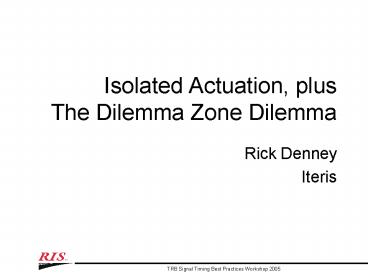Isolated Actuation, plus The Dilemma Zone Dilemma - PowerPoint PPT Presentation
1 / 22
Title:
Isolated Actuation, plus The Dilemma Zone Dilemma
Description:
Used in absence of stop-line detector. Add to the minimum green for each car that passes over loop ... close to the stop line, where detection is cheap and easy ... – PowerPoint PPT presentation
Number of Views:62
Avg rating:3.0/5.0
Title: Isolated Actuation, plus The Dilemma Zone Dilemma
1
Isolated Actuation, plusThe Dilemma Zone Dilemma
- Rick Denney
- Iteris
2
Actuated Controller Settings include
- Minimum Green (or Initial)
- Extension (or Passage)
- Volume-Density Variable Initial
- Volume-Density Variable Extension
- Maximum Green (or Maximum Extension)
- Coordination Settings
3
Minimum Green Settings
- Clears queue from stop line to first detector
- Typical formula (variations do exist) is the sum
of the startup time plus the time needed for each
car in queue
4
Volume Density Variable Initial
- Minimum initial
- Added initial (added per actuation)
- Maximum initial
5
Variable InitialDiagram
Red
Green
Yellow
Each actuation increases initial
Maximum Initial
Controller Time Settings
Added Initial
Minimum Initial
Extension
Vehicles Detected
Vehicles Detected
6
Variable Initial Settings
- Used in absence of stop-line detector
- Add to the minimum green for each car that passes
over loop - Typically added-per-actuation 2 sec.
- Minimum initial minimum green
- Maximum initial is 2 times the number of cars
that will fit between stop line and loop
7
Extension
- Maintains green when density is high
- Typically long enough for extending vehicle to
clear dilemma zone - With dilemma-zone detection, extension is part of
the design - With presence detection, extension long enough
for expected gap
8
Extension
- Extension X speed/(length of loop car),
where X depends on your goals
X
9
Extension
- Extension value a trade-off in heavy traffic
X?
10
Volume Density Variable Extension
- Variable extension (gap reduction)
- Time before reduction
- Minimum gap
- Time to reduce, or reduce by
11
Variable ExtensionDiagram
Green
Yellow
Time to Reduce, or Reduce By
Time Before Reduc-tion
Controller Time Settings
Extension
Minimum Gap
Initial Green
First Opposing Call
Gap Out
Vehicles Detected
12
Variable ExtensionDiagram
Green
Yellow
Time to Reduce, or Reduce By
Time Before Reduc-tion
Controller Time Settings
Extension
Queue Clearance
Minimum Gap
Queue Gone
Initial Green
First Opposing Call
Gap Out
Vehicles Detected
13
Variable Extension Settings
- Extension
- Generous for queue departure 2.5-3 sec.
- Time Before Reduction
- Long enough to clear typical queue
- Time to Reduce
- Typically 5-10 sec.
- Minimum Extension
- Short enough to only allow tight gaps 2 sec.
14
Maximum GreenDiagram
Green
Yellow
Red
Maximum Green
Phase timer reaches Max, phase maxes out and
terminates
Controller Time Settings
Maximum Extension
Initial or Minimum Green
Extension
Vehicles Detected
15
Maximum Green
- Doesnt care if you have dilemma zone protection
- Doesnt care if the queue is cleared
- Doesnt care if a platoon is arriving, but
- Often the only thing preventing insane cycle
lengths
16
Some Biased Questions
- Does the dilemma zone really exist?
- What is the real purpose of dilemma zone
protection? - Prevent accidents from cars going too fast, too
close? - Reward fast drivers with longer green?
17
Is There A Better Way?
- To improve safety without rewarding speeders?
- To keep cars from entering intersection
dangerously?
18
The Main Problem
- Dilemma zone protection set up at a point where
cars should start to stop, but - Its when they go that causes the problem
- DZ makes the decision to extend the green 6-9
seconds before the problem - Lots of detection infrastructure required, and
sluggish timing unavoidable
19
A Solution? (aka Research Needs)
- Delay the crossing green to prevent accidents,
but - Dont extend the green to reward the speeder
- Ergo A variable red clearance interval
20
Variable Red Clearance Advantages
- Not concerned with stopping distancestopping
cars are already stopping - Concerned with cars that are still going at the
end of the yellow - Measured close to the stop line, where detection
is cheap and easy - Detects problems where they exist instead of
projecting them 6-9 seconds back
21
Disadvantages
- Controllers dont work that way
- Needs research to discover hidden disadvantages
22
Summary (Yup, this is biased, too)
- Old methods used fancy timing to work with
limited detection - New methods use fancy detection layouts that add
more and more green time to serve less and less
traffic - None solve the problem Clearance problems should
affect clearance intervals, not green time































